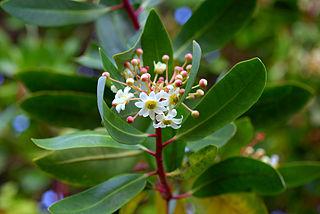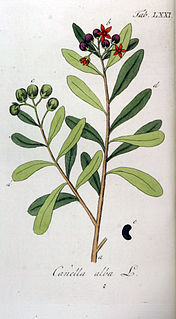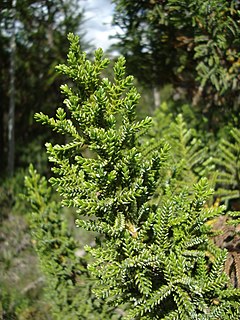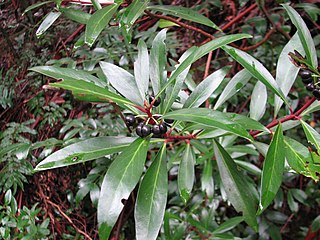
Perch is a common name for fish of the genus Perca, freshwater gamefish belonging to the family Percidae. The perch, of which three species occur in different geographical areas, lend their name to a large order of vertebrates: the Perciformes, from the Greek perke, simply meaning perch, and the Latin forma meaning shape. Many species of freshwater gamefish more or less resemble perch, but belong to different genera. In fact, the exclusively saltwater-dwelling red drum is often referred to as a red perch, though by definition perch are freshwater fish. Though many fish are referred to as perch as a common name, to be considered a true perch, the fish must be of the family Percidae.

Calamondin, also known as calamansi, is an economically-important citrus hybrid predominantly cultivated in the Philippines. It is native to the Philippines and surrounding areas in southern China, Taiwan, Borneo, and Sulawesi. Calamondin is ubiquitous in traditional Filipino cuisine. It is used in various condiments, beverages, dishes, marinades, and preserves. Calamondin is also used as ingredients in the cuisines of Malaysia and Indonesia.
In biology, a common name of a taxon or organism is a name that is based on the normal language of everyday life; this kind of name is often contrasted with the scientific name for the same organism, which is Latinized. A common name is sometimes frequently used, but that is by no means always the case.

Saponins are a class of chemical compounds found in particular abundance in various plant species. More specifically, they are amphipathic glycosides grouped phenomenologically by the soap-like foam they produce when shaken in aqueous solutions, and structurally by having one or more hydrophilic glycoside moieties combined with a lipophilic triterpene or steroid derivative.

Winteraceae is a primitive family of tropical trees and shrubs including 60 to 90 species in five genera. It is of particular interest because it is such a primitive angiosperm family, closely related to Magnoliaceae, though it has a much more southern distribution. Plants in this family grow mostly in the southern hemisphere, and have been found in tropical to temperate climate regions of Malesia, Oceania, eastern Australia, New Zealand, Madagascar and the Neotropics, with most of the genera are concentrated in Australasia and Malesia. Drimys is found in the Neotropic ecozone, from southern Mexico to the subarctic forests of southern South America. Takhtajania includes a single species, T. perrieri, endemic only to Madagascar.

The Canellaceae are a family of flowering plants in the order Canellales. The order includes only one other family, the Winteraceae. Canellaceae is native to the Afrotropic and Neotropic ecozones. They are small to medium trees, rarely shrubs, evergreen and aromatic. The flowers and fruit are often red.

Ixobrychus is a genus of bitterns, a group of wading bird in the heron family Ardeidae. Ixobrychus is from Ancient Greek ixias, a reed-like plant and brukhomai, to bellow.

Pilgerodendron is a genus of conifer belonging to the cypress family Cupressaceae. It has only one species, Pilgerodendron uviferum, and is endemic to the Valdivian temperate rain forests and Magellanic subpolar forests of southern Chile and southwestern Argentina. It grows from 40 to 55°S in Tierra del Fuego, where it is the southernmost conifer in the world. It is a member of subfamily Callitroideae, a group of distinct southern hemisphere genera associated with the Antarctic flora.

Tasmannia is a genus of woody, evergreen flowering plants of the family Winteraceae. The 40 species of Tasmannia are native to Australia, New Guinea, Sulawesi, Borneo, and the Philippines. The Winteraceae are magnoliids, and are associated with the humid Antarctic flora of the Southern Hemisphere. The members of the family generally have aromatic bark and leaves, and some are used to extract essential oils. The peppery-flavored fruits and leaves of this genus are increasingly used as a condiment in Australia. The peppery flavour can be attributed to polygodial.

Lutra is a genus of otters, one of seven in the subfamily Lutrinae.

Tasmannia lanceolata, commonly known as Tasmanian pepperberry, mountain pepper (Aus), or Cornish pepper leaf (UK), is a shrub native to woodlands and cool temperate rainforest of south-eastern Australia. The shrub varies from 2 to 10 m high. The aromatic leaves are lanceolate to narrow-elliptic or oblanceolate, 4–12 cm long, and 0.7–2.0 cm wide, with a distinctly pale undersurface. Stems are quite red in colour. The small cream or white flowers appear in summer and are followed by black, globose, two-lobed berries 5–8 mm wide, which appear in autumn. There are separate male and female plants.

Gracillariidae is an important family of insects in the order Lepidoptera and the principal family of leaf miners that includes several economic, horticultural or recently invasive pest species such as the horse-chestnut leaf miner, Cameraria ohridella.

Drimys winteri is a slender tree, growing up to 20 m (66 ft) tall. It is native to the Magellanic and Valdivian temperate rain forests of Chile and Argentina, where it is a dominant tree in the coastal evergreen forests. It is found below 1,200 m (3,937 ft) between latitude 32° south and Cape Horn at latitude 56°. In its southernmost natural range it can tolerate temperatures down to −20 °C (−4 °F).
The Central America bioregion is a biogeographic region comprising southern Mexico and Central America.

Tasmannia purpurascens, commonly known as the broad-leaved pepperbush or purple pepperbush is a shrub in the primitive family Winteraceae and is only found growing in the Barrington Tops and Ben Halls Gap regions of New South Wales. It is locally abundant in a restricted subalpine habitat with a high rainfall, often growing in the ecotone in association with Antarctic Beech.
Prophyllocnistis epidrimys is a moth of the family Gracillariidae. It is known from Chile.

Persoonia muelleri, commonly known as Mueller’s geebung, is a shrub endemic to Tasmania. It forms a shrub in open areas of wet forests in the west and northeast of the state. It is occasionally confused with P. gunnii though it has larger flowers and longer, straighter leaves.

Bulrushes is the vernacular name for several large wetland grass-like plants in the sedge family (Cyperaceae).













